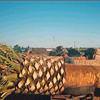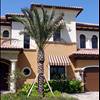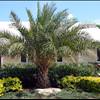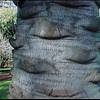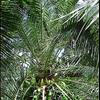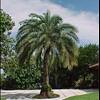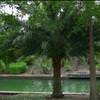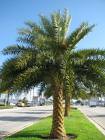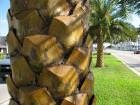This plant may be available to buy
Click the banana to see

|
Date Palm click pic to enlarge |
|
Zone 8-9-10 True Date palm has been in cultivation for over 3,000 years in the Arab Middle East and North Africa. In 1900, tons of Phoenix dactylifera suckers were taken, transported then brought to the United States. That was the start of the date industry in America. Recently, a 2,000 year old date palm seed was sprouted. Amazing details are here This is the Phoenix palm known as the true date palm because it produces large edible fruit, Phoenix dactylifera Not grown from seed in Florida, these green-gray colored palms come shipped from Arizona and California where commercial groves plant them to raise fruit As an illustration, here are some Pineapple Palms being prepared for transport click pics to enlarge Phoenix palms prefer dryer, cool night conditions so they fruit poorly in tropical and sub-tropical climates. However, you will see them planted (usually large) all over Florida click pic to enlarge Maximum color is in summer when fruit matures. You need both male and female trees to set seed/fruit. Besides fruit, Phoenix dactylifera can be tapped for sugar once a year and can yield as much as 6-8 pounds per extraction click pic to enlarge The dactylifera is slow growing but rated tall between 70-100 feet. It is clump growing palm, but it takes many years to see pups. Sprouts should be removed. Roots may also develop on the trunk over time, as high as 6 feet from the ground Typical is to artistically prune old frond to produce a fancy appearance on the trunk. Here's one way click pic to enlarge Note how the fronds, which can be 20 feet long, are held high and very upright versus the common palm frond habit of drooping or an umbrella look. It is this stately "high" look that appeals to many There are a number of popular named varieties:
Deglet Noor is a preferred variety in California's commercial groves. It produces large soft fruit. Each female tree produces over 200 lbs. a year For landscaping, the dactylifera is very expensive. They are typically sold as larger trees shipped at considerable expense from across the country. Expect to pay over $1,000 for a 12 footer plus a heavy planting charge as heavy equipment is always required. A 20 footer will run near $5,000 and a 30 footer near $7,000 plus planting and prep charges Most often dactylifera are seen planted in mansion landscapes. Here's another photo Fort Lauderdale planted a few on the beach at Las Olas Boulevard, yet they are not rated as salt tolerant, but they seem fine Another wonder dactylifera-style palm is the Wild Date palm, Phoenix sylvestris, here and below click pics to enlarge These Phoenix sylvestris palms are on planted on Federal Highway, US-1, in Pompano Beach, FL, and show a particular professional pruning styleclick pics to enlarge |


